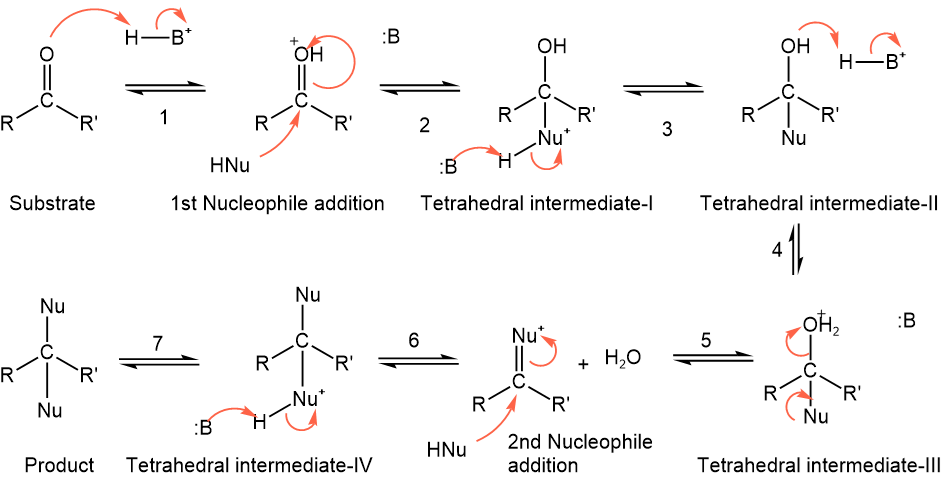4.6: Nucleophilic Addition Reactions
- Page ID
- 420737
\( \newcommand{\vecs}[1]{\overset { \scriptstyle \rightharpoonup} {\mathbf{#1}} } \)
\( \newcommand{\vecd}[1]{\overset{-\!-\!\rightharpoonup}{\vphantom{a}\smash {#1}}} \)
\( \newcommand{\id}{\mathrm{id}}\) \( \newcommand{\Span}{\mathrm{span}}\)
( \newcommand{\kernel}{\mathrm{null}\,}\) \( \newcommand{\range}{\mathrm{range}\,}\)
\( \newcommand{\RealPart}{\mathrm{Re}}\) \( \newcommand{\ImaginaryPart}{\mathrm{Im}}\)
\( \newcommand{\Argument}{\mathrm{Arg}}\) \( \newcommand{\norm}[1]{\| #1 \|}\)
\( \newcommand{\inner}[2]{\langle #1, #2 \rangle}\)
\( \newcommand{\Span}{\mathrm{span}}\)
\( \newcommand{\id}{\mathrm{id}}\)
\( \newcommand{\Span}{\mathrm{span}}\)
\( \newcommand{\kernel}{\mathrm{null}\,}\)
\( \newcommand{\range}{\mathrm{range}\,}\)
\( \newcommand{\RealPart}{\mathrm{Re}}\)
\( \newcommand{\ImaginaryPart}{\mathrm{Im}}\)
\( \newcommand{\Argument}{\mathrm{Arg}}\)
\( \newcommand{\norm}[1]{\| #1 \|}\)
\( \newcommand{\inner}[2]{\langle #1, #2 \rangle}\)
\( \newcommand{\Span}{\mathrm{span}}\) \( \newcommand{\AA}{\unicode[.8,0]{x212B}}\)
\( \newcommand{\vectorA}[1]{\vec{#1}} % arrow\)
\( \newcommand{\vectorAt}[1]{\vec{\text{#1}}} % arrow\)
\( \newcommand{\vectorB}[1]{\overset { \scriptstyle \rightharpoonup} {\mathbf{#1}} } \)
\( \newcommand{\vectorC}[1]{\textbf{#1}} \)
\( \newcommand{\vectorD}[1]{\overrightarrow{#1}} \)
\( \newcommand{\vectorDt}[1]{\overrightarrow{\text{#1}}} \)
\( \newcommand{\vectE}[1]{\overset{-\!-\!\rightharpoonup}{\vphantom{a}\smash{\mathbf {#1}}}} \)
\( \newcommand{\vecs}[1]{\overset { \scriptstyle \rightharpoonup} {\mathbf{#1}} } \)
\( \newcommand{\vecd}[1]{\overset{-\!-\!\rightharpoonup}{\vphantom{a}\smash {#1}}} \)
\(\newcommand{\avec}{\mathbf a}\) \(\newcommand{\bvec}{\mathbf b}\) \(\newcommand{\cvec}{\mathbf c}\) \(\newcommand{\dvec}{\mathbf d}\) \(\newcommand{\dtil}{\widetilde{\mathbf d}}\) \(\newcommand{\evec}{\mathbf e}\) \(\newcommand{\fvec}{\mathbf f}\) \(\newcommand{\nvec}{\mathbf n}\) \(\newcommand{\pvec}{\mathbf p}\) \(\newcommand{\qvec}{\mathbf q}\) \(\newcommand{\svec}{\mathbf s}\) \(\newcommand{\tvec}{\mathbf t}\) \(\newcommand{\uvec}{\mathbf u}\) \(\newcommand{\vvec}{\mathbf v}\) \(\newcommand{\wvec}{\mathbf w}\) \(\newcommand{\xvec}{\mathbf x}\) \(\newcommand{\yvec}{\mathbf y}\) \(\newcommand{\zvec}{\mathbf z}\) \(\newcommand{\rvec}{\mathbf r}\) \(\newcommand{\mvec}{\mathbf m}\) \(\newcommand{\zerovec}{\mathbf 0}\) \(\newcommand{\onevec}{\mathbf 1}\) \(\newcommand{\real}{\mathbb R}\) \(\newcommand{\twovec}[2]{\left[\begin{array}{r}#1 \\ #2 \end{array}\right]}\) \(\newcommand{\ctwovec}[2]{\left[\begin{array}{c}#1 \\ #2 \end{array}\right]}\) \(\newcommand{\threevec}[3]{\left[\begin{array}{r}#1 \\ #2 \\ #3 \end{array}\right]}\) \(\newcommand{\cthreevec}[3]{\left[\begin{array}{c}#1 \\ #2 \\ #3 \end{array}\right]}\) \(\newcommand{\fourvec}[4]{\left[\begin{array}{r}#1 \\ #2 \\ #3 \\ #4 \end{array}\right]}\) \(\newcommand{\cfourvec}[4]{\left[\begin{array}{c}#1 \\ #2 \\ #3 \\ #4 \end{array}\right]}\) \(\newcommand{\fivevec}[5]{\left[\begin{array}{r}#1 \\ #2 \\ #3 \\ #4 \\ #5 \\ \end{array}\right]}\) \(\newcommand{\cfivevec}[5]{\left[\begin{array}{c}#1 \\ #2 \\ #3 \\ #4 \\ #5 \\ \end{array}\right]}\) \(\newcommand{\mattwo}[4]{\left[\begin{array}{rr}#1 \amp #2 \\ #3 \amp #4 \\ \end{array}\right]}\) \(\newcommand{\laspan}[1]{\text{Span}\{#1\}}\) \(\newcommand{\bcal}{\cal B}\) \(\newcommand{\ccal}{\cal C}\) \(\newcommand{\scal}{\cal S}\) \(\newcommand{\wcal}{\cal W}\) \(\newcommand{\ecal}{\cal E}\) \(\newcommand{\coords}[2]{\left\{#1\right\}_{#2}}\) \(\newcommand{\gray}[1]{\color{gray}{#1}}\) \(\newcommand{\lgray}[1]{\color{lightgray}{#1}}\) \(\newcommand{\rank}{\operatorname{rank}}\) \(\newcommand{\row}{\text{Row}}\) \(\newcommand{\col}{\text{Col}}\) \(\renewcommand{\row}{\text{Row}}\) \(\newcommand{\nul}{\text{Nul}}\) \(\newcommand{\var}{\text{Var}}\) \(\newcommand{\corr}{\text{corr}}\) \(\newcommand{\len}[1]{\left|#1\right|}\) \(\newcommand{\bbar}{\overline{\bvec}}\) \(\newcommand{\bhat}{\widehat{\bvec}}\) \(\newcommand{\bperp}{\bvec^\perp}\) \(\newcommand{\xhat}{\widehat{\xvec}}\) \(\newcommand{\vhat}{\widehat{\vvec}}\) \(\newcommand{\uhat}{\widehat{\uvec}}\) \(\newcommand{\what}{\widehat{\wvec}}\) \(\newcommand{\Sighat}{\widehat{\Sigma}}\) \(\newcommand{\lt}{<}\) \(\newcommand{\gt}{>}\) \(\newcommand{\amp}{&}\) \(\definecolor{fillinmathshade}{gray}{0.9}\)- Understand and be able to draw nucleophilic addition mechanisms in basic and acidic mediums.
- Apply nucleophilic addition reactions to simple examples, like the addition of cyanide, water, and alcohols to aldehydes and ketones.
The carbonyl group of an aldehyde or a ketone is a polar double bond just like the acyl group of a carboxylic acid derivative, i.e., \(\ce{R-\!\!{\overset{\overset{\huge\enspace\!{\overset{\Large{\delta{-}}}{O}}}|\!\!|\enspace}{\overset{\delta{+}}{C}}}\!\!-R'}\) where the carbonyl \(\ce{\overset{\delta{+}}{C}}\) is an electrophile. However, this electrophile does not have a leaving group on it. It can add a nucleophile but usually needs ether base-promoted or acid catalysis conditions. These two mechanisms are described next.
Base-promoted nucleophilic addition reactions
A nucleophile in its more reactive basic form \(\ce{Nu^{-}}\) in basic medium attacks the electrophilic carbonyl \(\ce{\overset{\delta{+}}{C}}\). Simultaneously, the \(\pi\)-bond bond break, as shown in step#1 of the mechanism below. The \(\ce{O^{-}}\) either re-establish \(\pi\)-bond expelling the nucleophile, or it is neutralized by an acid-base reaction with any acid group present in the medium in step#2 of the mechanism shown below.

Remember, the medium is basic but amphoteric and has some acidic groups. If there is no sufficiently acidic group in the medium, an acid (\(\ce{HB^{+}}\)) is added after mixing the reactants for step#2 to happen. The carbonyl \(\ce{C}\) changes hybridization from sp2 to sp3, and \(\ce{C=O}\) group converts to an alcohol (\(\ce{-OH}\)) in this reaction. It is called nucleophilic addition reaction because the overall result is the addition of a nucleophile (\(\ce{HNu}\)) to a carbonyl (\(\ce{C=O}\)) group.
Cyanohydrin formation
The addition of cyanide (\(\ce{^{-}CN}\)) to aldehydes or ketones is an example of base-promoted nucleophilic addition. It converts the \(\ce{C=O}\) into cyanohydrin, i.e., a \(\ce{C}\) with a cyanide (\(\ce{-CN}\)) and hydroxyl (\(\ce{-OH}\) groups on it. Two examples of cyanohydrin formation are shown below.


Acid-catalyzed nucleophilic addition reactions
The acid in the medium converts less electrophilic \(\ce{R-\!\!{\overset{\overset{\huge\enspace\!{\overset{\Large{\delta{-}}}{O}}}|\!\!|\enspace}{\overset{\delta{+}}{C}}}\!\!-R'}\) to a more electrophilic \(\ce{R-\!\!\!\!\!\!{\overset{\overset{\huge\enspace\enspace{\overset{\Large{+}}{O}H}}|\!\!\!\!\!\!\!|\enspace\enspace}{\overset{\delta{+}}{C}}}\!\!\!\!\!\!-{R'}}\) form by protonating its \(\ce{O}\) in step#1. Neutral nucleophile can exist only in neutral (\(\ce{HNu}\)) form in the acidic medium. The neutral nucleophile (\(\ce{HNu}\)) attacks the carbonyl \(\ce{C}\) making a \(\sigma\)-bond and, simultaneously, the \(\ce\pi\)-bond breaks in step#2. Although the medium is acidic, it is amphoteric and has some basic groups that receive acidic proton on the incoming \(\ce{-{\overset{+}Nu}H}\) in step#3, as illustrated below.

The acidic medium converts bad leaving \(\ce{-OH}\)-group to a good leaving \(\ce{-\overset{+}{O}H2}\)-group in step#4. The \(\ce{-\overset{+}{O}H2}\)-group leaves as \(\ce{H2O}\), pushed by lone pair on \(\ce{-Nu}\) in step#5. Second \(\ce{HNu}\) attacks the electrophilic \(\ce{C}\) in step#6, and the acidic proton on the second incoming \(\ce{-\overset{+}{Nu}H}\) is removed by any base (\(\ce{:\!\!B}\)) in the medium in step#7. All the steps of the mechanism are reversible. Two situations can arise:
- if \(\ce{HNu}\) is in limited supply, equilibrium exists between the substrate and tetrahedral intermediate-II of step#3, and
- if \(\ce{HNu}\) is in excess, equilibrium exists between the substrate and the product of reation#7.
The reaction can be made irreversible by removing \(\ce{H2O}\) from the products. The reaction can be reversed by mixing the acid catalyst and excess water with the product.
Hydration of aldehydes and ketones
An example of nucleophilic addition is the hydration of aldehydes and ketones when diluted with water, as shown below.

The hydrates are usually unstable and exist in a very small proportion relative to the initial aldehyde or ketone, e.g., the hydrate of acetone, shown below.

A few exceptions exist where one or both of the groups attached with the carbonyl \(\ce{C}\) are \(\ce{H's}\), hydrate form is dominant, e.g., the hydrated acetaldehyde and formaldehyde, as shown below.


Hemiacetals and acetals
The addition of alcohol (\(\ce{R-OH}\)) to an aldehyde or a ketone is another example of a nucleophilic addition reaction. If \(\ce{R-OH}\) is in limited supply, the reaction stops after the addition of one \(\ce{R-OH}\) molecule resulting in a product called hemiacetal, as in the following example.

Hemiacetal has an \(\ce{-O-R}\)-group and an \(\ce{-OH}\) bonded to the same \(\ce{C}\). Hemiacetals are usually unstable and exist in small proportion at equilibrium. Exceptions are five-membered and six-membered hemiacetals formed by the reaction of (\(\ce{-OH}\))-group and the \(\ce{C=O}\)-group on the same molecule. For example, more than 99% of glucose molecules exist in six-membered hemiacetal forms in equilibrium with open-chain aldehyde form in a water solution, as shown in Figure \(\PageIndex{1}\).

When alcohol is in excess, a second \(\ce{R-OH}\) adds to the hemiacetal resulting in an acetal. An acetal has two \(\ce{-O-R}\)-groups bonded to the same \(\ce{C}\), as shown in the example below.

The acetal groups in carbohydrates are called glycoside linkages. Glycoside linkages connect monosaccharide units together in polysaccharides like starch and cellulose and in disaccharides, e.g., lactose, maltose, and sucrose, as shown in Figure \(\PageIndex{2}\)



